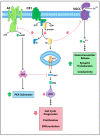Cannabinoid Receptor Interacting Protein 1a (CRIP1a) in Health and Disease
- PMID: 33261012
- PMCID: PMC7761089
- DOI: 10.3390/biom10121609
Cannabinoid Receptor Interacting Protein 1a (CRIP1a) in Health and Disease
Abstract
Endocannabinoid signaling depends upon the CB1 and CB2 cannabinoid receptors, their endogenous ligands anandamide and 2-arachidonoylglycerol, and intracellular proteins that mediate responses via the C-terminal and other intracellular receptor domains. The CB1 receptor regulates and is regulated by associated G proteins predominantly of the Gi/o subtypes, β-arrestins 1 and 2, and the cannabinoid receptor-interacting protein 1a (CRIP1a). Evidence for a physiological role for CRIP1a is emerging as data regarding the cellular localization and function of CRIP1a are generated. Here we summarize the neuronal distribution and role of CRIP1a in endocannabinoid signaling, as well as discuss investigations linking CRIP1a to development, vision and hearing sensory systems, hippocampus and seizure regulation, and psychiatric disorders including schizophrenia. We also examine the genetic and epigenetic association of CRIP1a within a variety of cancer subtypes. This review provides evidence upon which to base future investigations on the function of CRIP1a in health and disease.
Keywords: G protein-coupled receptors (GPCRs), hippocampus; cancer; embryonic development; endocannabinoids; epilepsy; retina; schizophrenia; seizures.
Conflict of interest statement
The authors declare no conflict of interest. The funders had no role in the design of the study; in the collection, analyses, or interpretation of data; in the writing of the manuscript, or in the decision to publish the results.
Figures





Similar articles
-
Cannabinoid Receptor Interacting Protein 1a (CRIP1a): Function and Structure.Molecules. 2019 Oct 12;24(20):3672. doi: 10.3390/molecules24203672. Molecules. 2019. PMID: 31614728 Free PMC article. Review.
-
Cannabinoid receptor interacting protein 1a interacts with myristoylated Gαi N terminus via a unique gapped β-barrel structure.J Biol Chem. 2021 Sep;297(3):101099. doi: 10.1016/j.jbc.2021.101099. Epub 2021 Aug 19. J Biol Chem. 2021. PMID: 34418434 Free PMC article.
-
Cannabinoid receptor-interacting protein 1a modulates CB1 receptor signaling and regulation.Mol Pharmacol. 2015 Apr;87(4):747-65. doi: 10.1124/mol.114.096495. Epub 2015 Feb 5. Mol Pharmacol. 2015. PMID: 25657338 Free PMC article.
-
CB1 cannabinoid receptor activity is modulated by the cannabinoid receptor interacting protein CRIP 1a.Mol Pharmacol. 2007 Dec;72(6):1557-66. doi: 10.1124/mol.107.039263. Epub 2007 Sep 25. Mol Pharmacol. 2007. PMID: 17895407
-
Physiological roles of 2-arachidonoylglycerol, an endogenous cannabinoid receptor ligand.Biofactors. 2009 Jan-Feb;35(1):88-97. doi: 10.1002/biof.18. Biofactors. 2009. PMID: 19319851 Review.
Cited by
-
Role of the Endocannabinoid System in the Regulation of Intestinal Homeostasis.Cell Mol Gastroenterol Hepatol. 2022;14(4):947-963. doi: 10.1016/j.jcmgh.2022.05.015. Epub 2022 Jun 22. Cell Mol Gastroenterol Hepatol. 2022. PMID: 35750314 Free PMC article. Review.
-
Quality of Life and a Surveillant Endocannabinoid System.Front Neurosci. 2021 Oct 28;15:747229. doi: 10.3389/fnins.2021.747229. eCollection 2021. Front Neurosci. 2021. PMID: 34776851 Free PMC article. Review.
-
The Role of Ion Channels and Intracellular Signaling Cascades in the Inhibitory Action of WIN 55,212-2 upon Hyperexcitation.Brain Sci. 2024 Jun 29;14(7):668. doi: 10.3390/brainsci14070668. Brain Sci. 2024. PMID: 39061409 Free PMC article.
-
Impact of Omega-3 on Endocannabinoid System Expression and Function, Enhancing Cognition and Behavior in Male Mice.Nutrients. 2024 Dec 17;16(24):4344. doi: 10.3390/nu16244344. Nutrients. 2024. PMID: 39770965 Free PMC article.
-
Omega-3 Fatty Acids Mitigate Long-Lasting Disruption of the Endocannabinoid System in the Adult Mouse Hippocampus Following Adolescent Binge Drinking.Int J Mol Sci. 2025 Jun 9;26(12):5507. doi: 10.3390/ijms26125507. Int J Mol Sci. 2025. PMID: 40564971 Free PMC article.
References
Publication types
MeSH terms
Substances
Grants and funding
LinkOut - more resources
Full Text Sources
Medical
Molecular Biology Databases

